The Object is a new interview series with Scotland-based makers, that explores the story behind a singular craft object.
This series offers an insight into each maker’s creative process and the materials, techniques and ideas that make their work unique.
In our first instalment, glass-artist Keiko Mukaide tells us about her work, “Unopened letter from my mother”, the inspiration behind it, and the challenges of working with glass and paper together.
Please note this interview discusses illness, death and grief.
Hello Keiko, can you tell us a bit more about you and your practice?
I am originally from Japan, and I moved from London to Edinburgh, where I set up my studio at WASPS Patriothall.
Over the years, my work has developed from smaller objects to large-scale, site-specific installations, although in recent years, my work has scaled down and I have simplified my technique. Just around the time of the first lockdown, my husband was diagnosed with cancer, so we try to live a quiet, stress-free, healthy life in our rural house. This way of life, fully living each day and enjoying the seasons, is the core of my new practice.
I've always been fascinated by glass as a material. It is elusive, transparent like water, it can reflect, it can let colour through, it can soften, it can harden, it can be transformed into any shape. Yet it has an authenticity that plastic does not have.
I do not use any specific, fixed techniques in my glass making process. I learn new techniques and develop them depending on the idea or concept I work with.
Which object have you chosen, and what inspired you to create it?
I chose “Unopened letter from my mother”, part of a glass book series that fused Japanese paper between glass sheets.
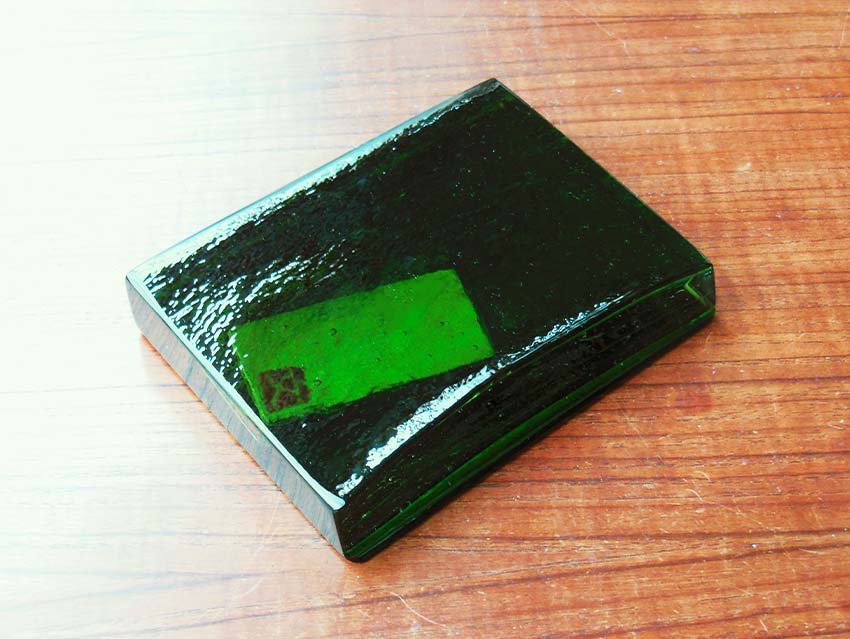
“Unopened letter from my mother, green book”, washi paper fused into glass, size H3 x W13.4 x D18cm. Keiko Mukaide / Photography by the artist
I developed this series for the group exhibition transFORM, which showed at WASPS Patriothall, Robert Gordon University Aberdeen, and Rotheshall Glenrothes between 2015-2016.
This work was born out of personal experience, caring for my parents in Japan for a month or so over the last 15 years. This time allowed me to consider family relationships, especially the relationship with my parents, and the nature of the Japanese people.
My parents' house was full of stuff, but I felt these were too difficult to throw away, as I had an emotional attachment to them. I've always been interested in recycling, but when you attach a memory to something it brings another dimension to it. This was my starting point for developing the glass book series idea.
When I was caring for my aging mother in Japan, I noticed that her memory had faded and that she would make up stories. It was irritating, but sometimes funny too. There were many old things in my parents’ house that would become meaningless after their owner lost their memories.
I discovered a pile of fine Japanese paper in a storage room that my mother had collected for her ink painting, even though she could not practice anymore. Paper is deeply ingrained in the Japanese traditional way of life. It is always recycled, and reused in many ways including for recording, writing, drawing, for communication, making garment, decoration, and even used as a building material. How could I throw this paper away as an artist?
I also noticed that my mother's name, FUMI, literally means “sentence”, “writing” and “letter”. She used to put a red stamp on her drawings with the Chinese character 文 “FUMI”, a part of her name.
The creative process begins with a story, which I then visualise in a way that embodies what the material of glass can express. The story of the glass book series is that of a stubborn young daughter who could not accept her mother's advice, and discovers her mother’s letters in a book after she has passed away.
Can you tell us more about your process, materials and techniques used to create this work?
The theme of the transFORM exhibition was recycle and reuse.
For this work, I wanted to give a new life to things that have lost the meaning of their existence. I brought home a bag of Japanese paper from my mother, and I bought second-hand books and second-hand glassware from charity shops. Unfortunately, most of the glassware could not melt successfully due to its quality. Instead, I had to order new sheets of glass.
I used Bullseye sheets glass because they have a vast range of both colour and clear glass that could be fused together. I needed coloured glass for the cover of the book and the same coefficient expansion glass to make the inside of the book transparent. Bullseye is an American manufacturer and has many distributors across the world.
I find that constraints and a clear picture of my idea can help me get off to a good start. In this case, there were clear constraints from the beginning: the use of Japanese paper and the Japanese imagery of the letter between the glass pages.
The process of forming glass objects requires a precise technique, but to fuse actual paper between glass sheets presented a technical challenge as most of the paper could be burnt away and disintegrate during the firing process.
There was no guidebook for paper fusing on this type of glass. In this case, I did a lot of tests to find a firing method close to the image. It's like sketching without drawing. It's fun because you have a clear idea of what you want, but on the other hand it can be very disappointing and frustrating when you start walking into unknown areas.
I managed to fuse the paper elements between glass sheets, as a hidden letter with a red stamp of my mother’ initials, which is a symbol with an important message.
I believe that the “3 H” - Head, Hands and Heart - should be well connected. It's not just about the idea, it's not just about the technique, it's about the heart, it's about the joy and curiosity in your heart, and not just about anyone else.
I have said that I learn and create the techniques according to my idea, this allows flexibility to try different techniques depending on the concept. For the sake of ideas, I have learnt UV gluing, lamp work, gilding and mosaic techniques. In kiln work, the right firing temperature depends on the texture you want. It is up to you to find the right firing temperature and programmes.
How has the object evolved since its creation and where is it now?
As galleries and WASPS studio were closed throughout the pandemic, my husband and I lived peacefully in the countryside. During this time my husband built a summerhouse in the garden using completely recycled materials, including windows and disused furniture that he had been saving for years. When I walked into the house, I felt an indescribable sense of nostalgia and security and I wanted to sit there forever. There, I displayed the glass book of my mother's memories and talked to local visitors during the Largo Art Week in July 2021.
The Largo Art Week was a great awakening for me, as I was able to exhibit my work in my own garden. I realised that I was aiming for an interaction between the object and the place where it would be exhibited, where the magic would happen. It also showed me the importance of starting with small experiments close to home, rather than with adventures that involve big risks, which I hadn’t noticed before.
This experience changed my relationship to the object, “Unopened letter from my mother”. I started to think about the meaning of my work, instead of being influenced by materials and techniques. The use of my mother's Japanese paper brought a story to my mind, and I want to bring out more of it.
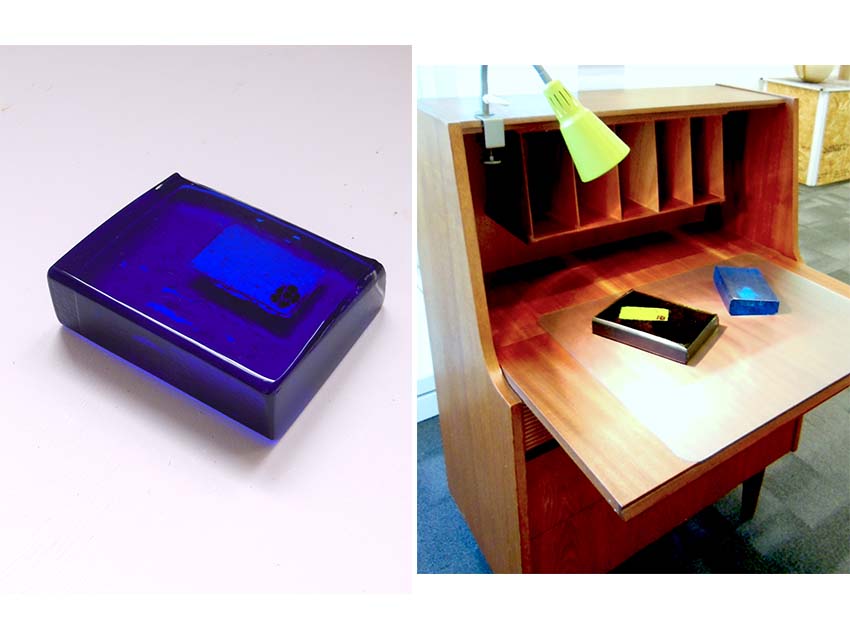
“Unopened letter from mother, blue book”, Keiko Mukaide / Photography by the artist // “Unopened letter from mother” on display. Keiko Mukaide / Photography by the artist
Being able to exhibit my glass books at the summerhouse in the garden has also made me want to do things that involve people and expand the meaning of my work. Every new piece starts with a dialogue. It is a collaborative process, and it is important to listen attentively. The result is a unique and original work of art.
This led me to my next project idea. At a local studio opening in the autumn, I will set a comfortable seating area in the summerhouse, invite guests for dialogue, and create a work of art based on their memories and thought. Glass and other materials may be mixed, but the main ingredients are curiosity and an open heart, a story where Head, Hands and Heart come together.
How does the final environment and intended presentation of your work influence your process?
The final environment (light, height, scale of the space etc.) and the way in which the work is presented has a great influence on my work. I started doing installations because I wasn't satisfied with the way glass works were displayed in galleries at the time, and I wanted to create my own environment in which to show them.
I exhibited in various places, such as the Royal Botanic Gardens Edinburgh, the Hill House, Talbot Rice Gallery, Tate St Ives and York St Mary's Church, all with their own histories, their own ways of engaging with people, and their own energies.
It was also fun to build a story from the impressions of the building on me. I wondered how the glass would react to the different kinds of lights and atmosphere that existed there, what kind of glass would be best to represent the space’s energy, and whether it would be appropriate for the place.
Of course, there are physical constraints - in some old buildings there is no place to hang heavy glass - so I try to find a compromise.
And when my work finds its magic in a space, it's usually the invigilators who enjoy it the most, because they spend a lot of time with it, and they can experience the changing light.
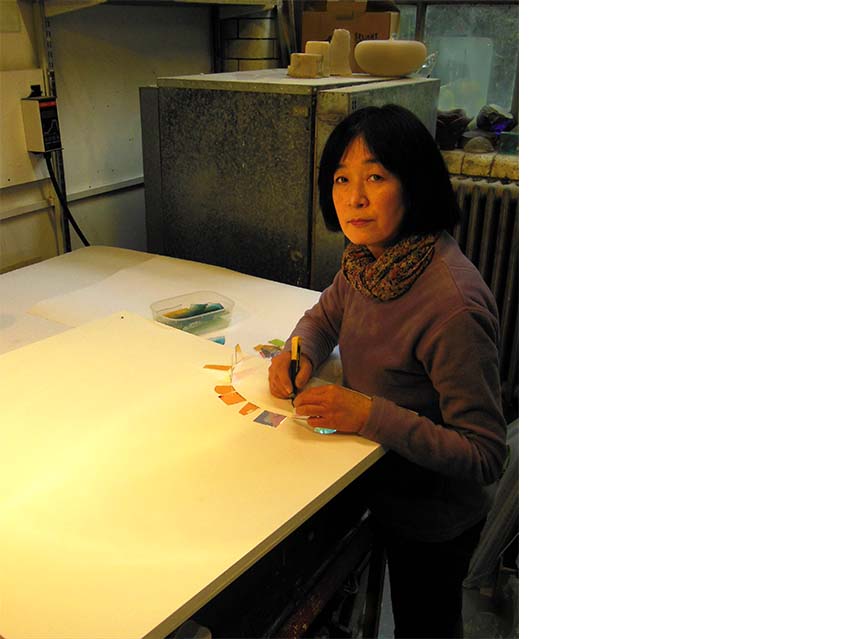
Keiko Mukaide in her studio / Photographer unknown
Keiko Mukaide lives and works in Edinburgh. Find her work on her website at www.keikomukaide.com and on Instagram.
This interview has been lightly edited for clarity.
Read More
-
Full details→
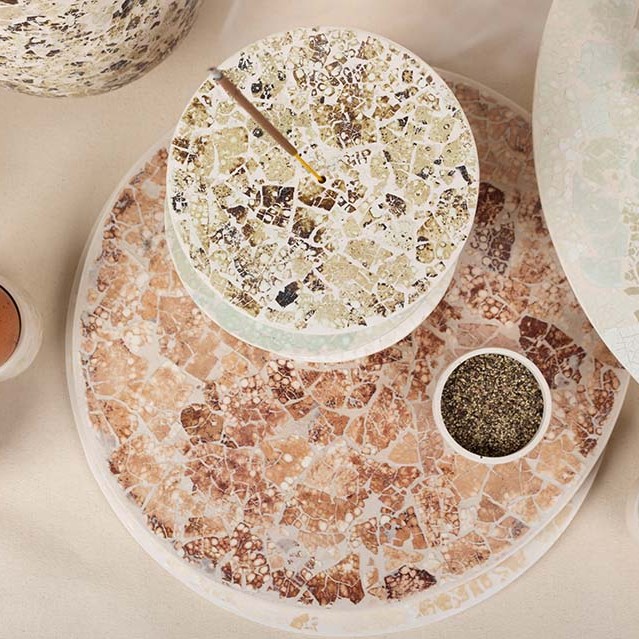
Interview and.ILC melds making & cooking - Jorum Craft Award
Learn about winner of Round 2 of the Jorum Craft Award, Isla Cruickshank, who brings her experiences as a cook into her craft practice.
1 Oct 2021
-
Full details→
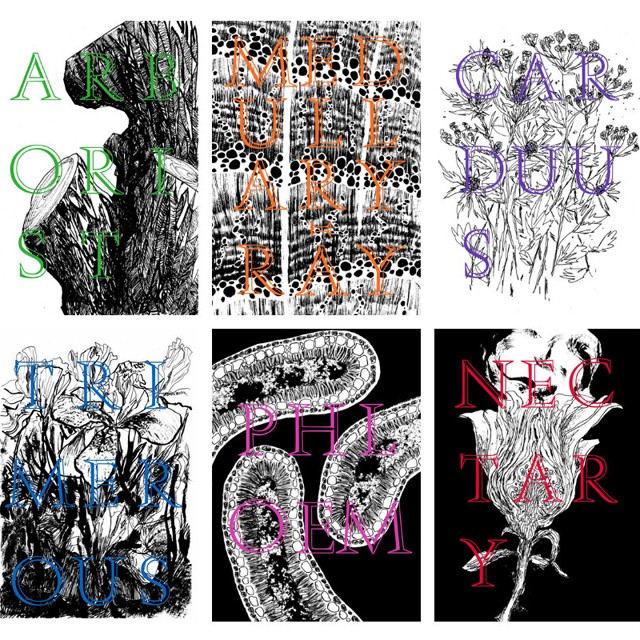
Interview All the senses – Jorum Studio launch New Award
Scottish perfumer Jorum Studio and Craft Scotland are delighted to launch the Jorum Craft Award in July 2020. We talk to Jorum Studio founders Chloe Mullen and Euan McCall about the project.
1 Jul 2020
-
Full details→
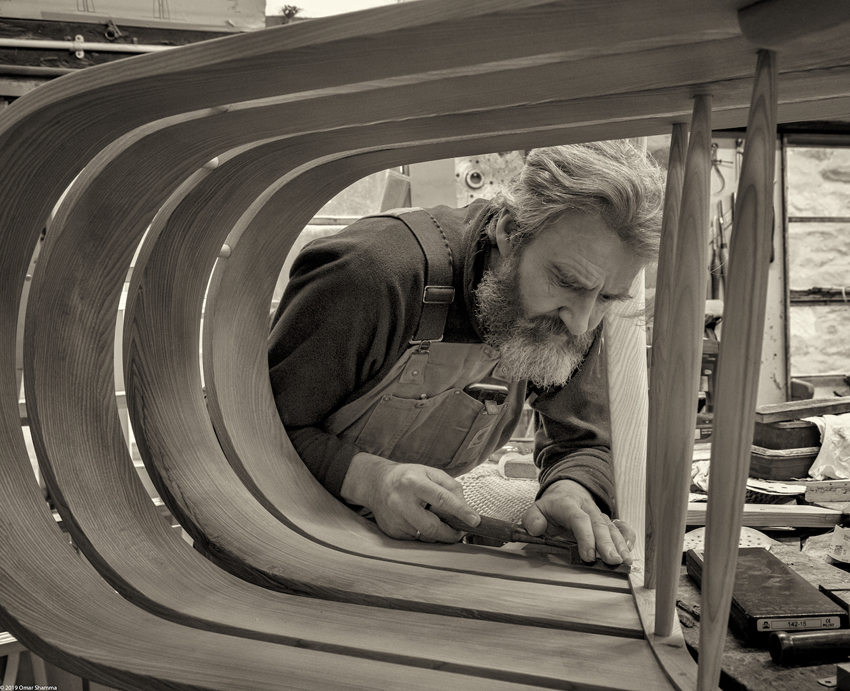
Make It Green Angus Ross: The maker protecting 50-acres of Scottish woodland
Meet the maker protecting 50-acres of Scottish woodland. Angus Ross creates a range of tactile furniture from Scottish Oak.
9 Oct 2019
-
Full details→
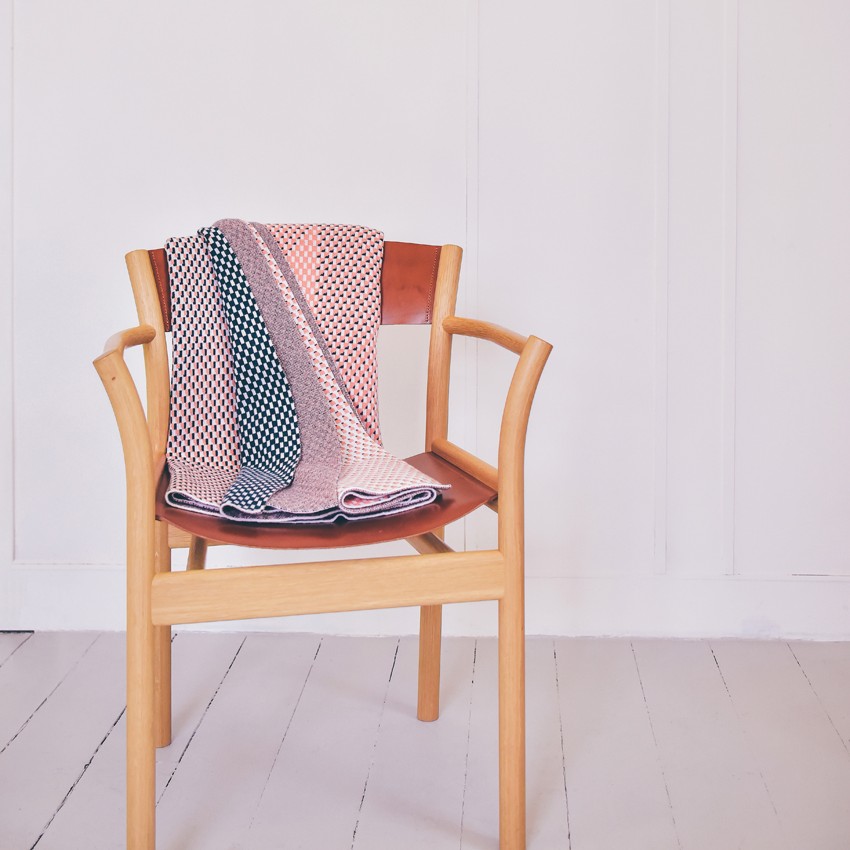
Interview Designing stitch by stitch
We’ve been catching up with the makers featured in the Scotland: Craft & Design pavilion throughout September. Finally, we have Hilary Grant, who together with design partner Rob Harvey, create intricate…
20 Sep 2017
-
Full details→
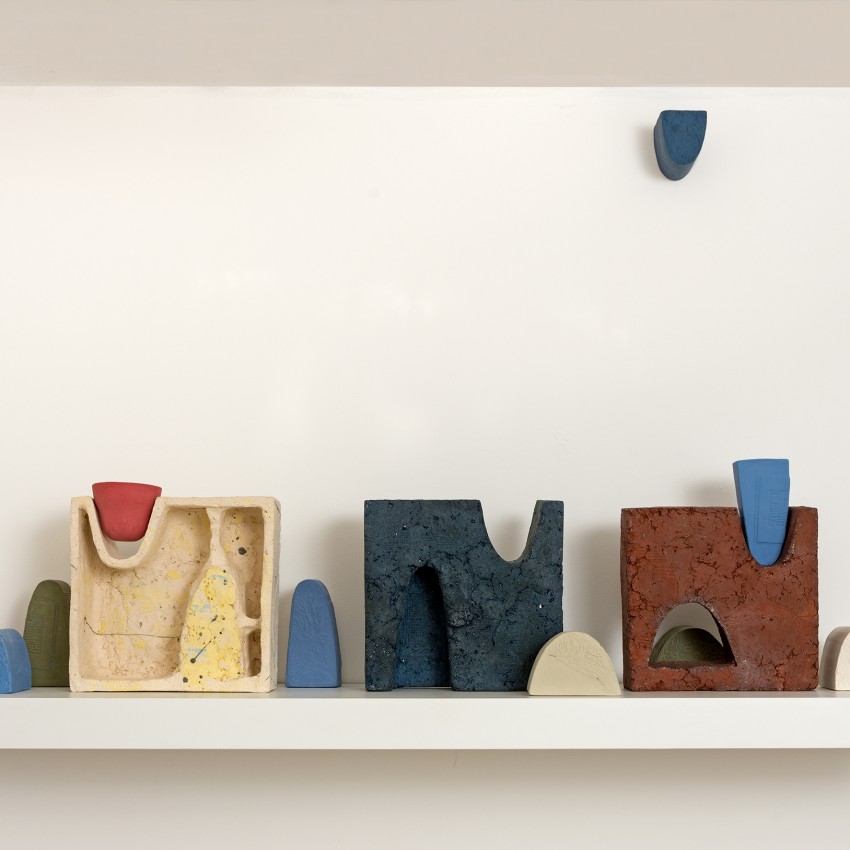
Interview Deconstructing the narrative of ceramics
We’ve caught up with ceramic artist Fiona Byrne-Sutton to discover the roots of her Italian Renaissance inspiration and her must see designers at this year’s London Design Fair.
8 Sep 2017
-
Full details→
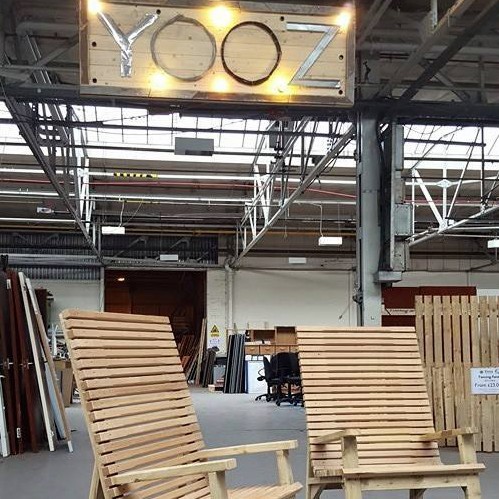
Make It Green Don't Dump It, Recycle It!
Once you have sourced sustainable materials and turned them into wonderful craft pieces, what do you do with the leftover bits and bobs?
26 Jul 2016
-
Full details→
![and.ILC melds making & cooking - Jorum Craft Award]()
Interview and.ILC melds making & cooking - Jorum Craft Award
Learn about winner of Round 2 of the Jorum Craft Award, Isla Cruickshank, who brings her experiences as a cook into her craft practice.
1 Oct 2021
-
Full details→
![All the senses – Jorum Studio launch New Award]()
Interview All the senses – Jorum Studio launch New Award
Scottish perfumer Jorum Studio and Craft Scotland are delighted to launch the Jorum Craft Award in July 2020. We talk to Jorum Studio founders Chloe Mullen and Euan McCall about the project.
1 Jul 2020
-
Full details→
![Angus Ross: The maker protecting 50-acres of Scottish woodland]()
Make It Green Angus Ross: The maker protecting 50-acres of Scottish woodland
Meet the maker protecting 50-acres of Scottish woodland. Angus Ross creates a range of tactile furniture from Scottish Oak.
9 Oct 2019
-
Full details→
![Designing stitch by stitch]()
Interview Designing stitch by stitch
We’ve been catching up with the makers featured in the Scotland: Craft & Design pavilion throughout September. Finally, we have Hilary Grant, who together with design partner Rob Harvey, create intricate…
20 Sep 2017
-
Full details→
![Deconstructing the narrative of ceramics]()
Interview Deconstructing the narrative of ceramics
We’ve caught up with ceramic artist Fiona Byrne-Sutton to discover the roots of her Italian Renaissance inspiration and her must see designers at this year’s London Design Fair.
8 Sep 2017
-
Full details→
![Don't Dump It, Recycle It!]()
Make It Green Don't Dump It, Recycle It!
Once you have sourced sustainable materials and turned them into wonderful craft pieces, what do you do with the leftover bits and bobs?
26 Jul 2016